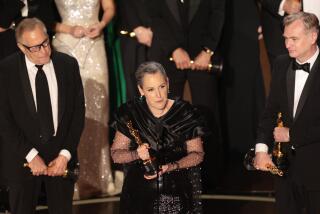Gold Standard: The best picture race is a jumble, but here’s a couple ways it could go

Let’s start with a dollop of Oscar trivia.
Can you name the last time the lead actress Oscar winner came from the movie that also won the Academy Award for best picture?
Thirteen years have passed. (I’ll wait.) It was the actress’ second Oscar. (Take your time.) Yes? Ding-ding-ding, you win … Hilary Swank, “Million Dollar Baby.” (Or maybe you don’t feel like a winner if you’re one of those Annette Bening fans still irked that she doesn’t have an Oscar because, in part, she was passed over for “Being Julia” that year.)
That actress-picture dry spell was going to end last year. Emma Stone held up her end of the deal, as did “La La Land” — for about two minutes.
But it’s in play again this year as several of this season’s best picture contenders — “Lady Bird,” “Three Billboards Outside Ebbing, Missouri,” “The Post,” “The Shape of Water,” among them — are movies driven by women. If you subscribe to the idea that Saoirse Ronan, Frances McDormand and Sally Hawkins are the front-runners for the lead actress Oscar (it’s a tight race; talk to me after the SAG Awards), then maybe the best picture winner will finally match, with “Lady Bird,” “Three Billboards” or “The Shape of Water” prevailing.
Either that or “Get Out” will win.
This year’s jumbled best picture Oscar race lends itself to all kinds of postulating, much of it, thankfully, more interesting than wondering if, say, “Dunkirk,” can win the top prize if it doesn’t get any kind of acting nomination. (It can’t. More precisely, it won’t, but not because it’ll be shut out from the acting categories. Too many academy members simply don’t care for the movie. They admired the craft, but couldn’t find the humanity. It left them cold.)
WATCH: Video Q&A’s from this season’s hottest contenders »
One interesting thread (alas, not a “Phantom Thread” thread; I fear Paul Thomas Anderson’s layered love story might have arrived too late to generate enough best picture momentum) involves the academy members’ voting psychology. Why do they vote the way they do? Are they voting with their hearts? Their politics? Out of a desire to be seen as relevant and not out-of-touch?
After “Moonlight” shocked “La La Land” last year — and, envelope gaffe or no, its victory ranks as one of the biggest upsets in Oscar history — pundits tried to explain how a micro-budget drama about (among many things) a young man growing up poor, gay and black triumphed over a feel-good, throwback musical that had earned a record-tying 14 nominations.
Was the academy defiantly extending a middle finger to incoming President Trump by celebrating a daring movie that looked, with dignity and grace, at those living on the margins of society and the roadblocks placed before them? Were voters not quite as gaga about the “La La” as those 14 Oscar nominations led us to believe? Did Ryan Gosling simply not explain jazz to enough people’s liking? (It should be noted that “La La Land” did win six Oscars, including one for director Damien Chazelle. This wasn’t some kind of massive, “Gangs of New York”-style shutout.)
The best picture Oscar, the culmination of a (sometimes) seemingly endless evening of self-congratulation, has always been a way of academy members telling the world: “See this movie. Forget those sequels and retreads. This is what we’re about.” For most of its history, craft (sometimes stodgy, sometimes exhilarating, typically middle-of-the-road) prevailed with inoffensive political messages sometimes promoted. (Gandhi good. Vietnam bad.)
“Moonlight” prevailed despite that history. Its victory could easily be an anomaly. Or it could be the start of something new. In the last two years, the academy has added 1,457 members — more women, more minorities, more international filmmakers. That means 20% of its current voters weren’t around when “Spotlight” won best picture.
We’ll have a better idea in a couple of weeks of the kinds of movies these new voters value. Aside from “Moonlight” winning, last year’s slate of nominees — inclusive (kind of) as it was — delivered plenty of mixed messages. Mel Gibson’s “Hacksaw Ridge” was nominated for best picture, after all, as was Gibson for a comeback that many didn’t embrace.
But there is one contender that actually arrived in theaters before “Moonlight” won the Oscar, and, nearly a year after its release, it’s still the movie generating the most discussion. If academy members want a sequel to last year’s Oscars reflecting the cultural moment, then “Get Out” will be this year’s best picture winner. A movie about white liberals being blind to institutional racism? That might be a message Hollywood can’t help but acknowledge with a grand gesture.
Twitter: @glennwhipp
More to Read
From the Oscars to the Emmys.
Get the Envelope newsletter for exclusive awards season coverage, behind-the-scenes stories from the Envelope podcast and columnist Glenn Whipp’s must-read analysis.
You may occasionally receive promotional content from the Los Angeles Times.








